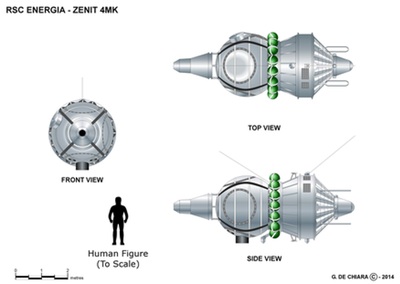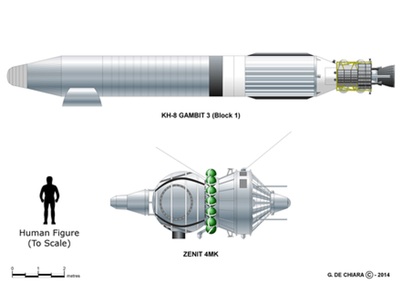Close encounters of the top secret kindby Dwayne A. Day
|
| The GAMBIT was supposed to enter an essentially circular orbit. But the Agena malfunctioned and it fired for far longer than it was supposed to. |
Starting in 1966, GAMBIT-1 was gradually replaced started by the GAMBIT-3, whose camera system was also designated “KH-8.” The GAMBIT-3 looked like an even longer pencil, and it kept its Agena D upper stage attached in orbit to provide power and stabilization. GAMBIT-3 was more powerful than its predecessor, and versions launched in the late 1970s could produce images of objects on the ground about 6.4 centimeters (2.5 inches) across. By mid-1967 the GAMBIT-3s had completely taken over the mission from the GAMBIT-1 and the United States was launching GAMBIT-3s at the rate of one every couple of months, and occasionally once a month. GAMBIT-3 was an important method for gathering information on Soviet weapons capabilities.
On January 22, 1969, the US Air Force launched a Titan IIIB-Agena D rocket from Vandenberg Air Force Base in California. Atop the rocket was the nineteenth GAMBIT-3, designated Mission 4319. The tall, thin rocket arced out over the Pacific Ocean and headed south, climbing steadily as it sailed past Santa Barbara and Los Angeles, shedding its Titan III first stage and firing its Agena upper stage.
The GAMBIT was supposed to enter an essentially circular orbit. But the Agena malfunctioned and it fired for far longer than it was supposed to. As a result, the spacecraft went into an orbit that was 132 kilometers at its lowest point, and 1090 kilometers at its highest point. It was inclined 106.1 degrees to the equator.
 Zenit reconnaissance satellite. The Soviet Union introduced the Zenit-4M version of its venerable reconnaissance satellite in late 1968. It included an orbit adjust rocket that enabled the satellite to maneuver. This maneuvering capabilities made American military and intelligence officials nervous in January 1969 when the second Zenit-4M came within only a few dozen kilometers of an American GAMBIT-3 reconnaissance satellite. See a larger version of above image. (credit: Giuseppe de Chiara) |
The Zenit-4M
The next day, January 23, 1969, the Soviet Union launched its second Zenit-4M high-resolution reconnaissance satellite, designated Kosmos-264. Although the capabilities of the Zenit-4M remain classified today, simple physics indicates that it could not have been anywhere near as powerful as the GAMBIT-3, because it lacked the large aperture mirrors of the American satellite.
In contrast to the austere cylinder of the GAMBIT-3, the Zenit-4M was a complicated jumble of parts. It was based on the Vostok manned spacecraft and had a large pressurized sphere at the middle and a semi-conical support structure on the bottom, making it look somewhat like a squashed ice cream cone. The Zenit-4M was an improvement over its predecessors by adding an Isayev orbit adjust engine atop the sphere, enabling it to boost its orbit and extend its lifetime, and making its appearance even uglier than earlier versions. Because this was only the second launch, the system was still being tested, and thus during the mission the Soviet flight controllers fired the Isayev engine a number of times, adjusting the orbit of their satellite—and gaining the attention of the United States.
Celestial maneuvers in the dark
According to an official history, “Critical to US Security: The Gambit and Hexagon Satellite Reconnaissance Systems,” produced by the National Reconnaissance Office and released in 2012, some at the National Reconnaissance Office quickly took notice of Kosmos-264’s orbital maneuvers:
“Gambit program officials strongly believed that neither the Soviets, nor anyone else, knew the capability of the Gambit program. In 1969, however, officials held their breath as a Soviet satellite, Kosmos 264, began to make orbital adjustments that U.S. engineers calculated would bring it within 70 miles [113 kilometers] of Gambit-3. Eventually the two satellites passed within 15 miles [24 kilometers] of each other as NRO controllers held their breath, wondering if Kosmos was a ‘killer satellite.’”
| “Eventually the two satellites passed within 15 miles [24 kilometers] of each other as NRO controllers held their breath, wondering if Kosmos was a ‘killer satellite.’” |
Their concern was likely prompted by something that had happened only a few months earlier. In October and November 1968, the Soviets conducted several tests of their new anti-satellite system. A target satellite, Kosmos-248, was launched into a roughly circular orbit. The ASAT worked by entering into an orbit similar to its target, getting nearby during apogee, when both were moving the slowest, and then firing a shotgun-like explosive in the direction of its target. Kosmos-249, either by design or malfunction (sources disagree) failed to destroy Kosmos-248 in late October. But Kosmos-252 launched on November first from the Baikonur Cosmodrome, and that same day it maneuvered near Kosmos-248 and exploded, apparently successfully destroying the target satellite. The Americans had monitored the Soviet ASAT’s progress—there was no way that they could miss the debris field that the explosion generated—and it made them nervous that their own satellites were now in Soviet crosshairs.
Twenty times faster than a speeding bullet
Jonathan McDowell, an astrophysicist working at the Harvard-Smithsonian Astrophysical Observatory in Cambridge, Massachusetts, recently processed some of the existing orbital data from the two reconnaissance spacecraft. The data is incomplete. For instance, the orbital information only exists for some days and not the full time that both spacecraft were in orbit. In addition, McDowell’s tracking program does not take into account the effects of atmospheric drag, which is important for satellites in very low orbits, such as Kosmos-264 and GAMBIT-3 Mission 4319. Without this data, McDowell could not compute the exact day that the two satellites flew within 24 kilometers of each other.
Despite these limitations, Dr. McDowell was able to draw several conclusions about the event. By the latter part of January 1969, the satellites passed each other daily at a distance of several dozen kilometers. But the GAMBIT’s highly elliptical orbit meant that the passes were all at GAMBIT’s perigee, or closest approach to the Earth, when the spacecraft was also traveling fastest. This was also the worst time to try to intercept it.
McDowell also noted another significant factor: the two spacecraft were traveling in opposite directions around the Earth. As a result, they were passing each other at a relative velocity of 15.5 kilometers per second, twice orbital velocity. The average bullet travels 0.76 kilometers per second, or about one twentieth the speed that the two satellites zipped past each other. If the Soviets were trying to intercept the GAMBIT, or just to photograph it with their Zenit-4M’s cameras, this was the worst possible way to try to catch it. Back in 1969, the Air Force and NRO officials looking at the orbital tracks of the two satellites would have come to the same conclusions relatively quickly: Kosmos-264 posed no threat to GAMBIT 4319.
RSEN
In 1964, an American CORONA satellite had photographed another spacecraft in orbit. This was apparently an accidental catch and not planned ahead of time. At the same time, the US Air Force also had a spacecraft named Program 437AP equipped with a camera to photograph Soviet satellites. Although it flew some test flights, and apparently photographed a spent Agena upper stage in orbit, Program 437AP was soon canceled.
| Although it is possible that, in 1969, the Zenit-4M was capable of photographing other satellites in orbit, it seems highly unlikely that the Soviets would attempt this when the two spacecraft were traveling in opposite directions. |
The United States did not develop the capability to use the GAMBIT to photograph other satellites until the early 1970s. That effort, prompted in large part by the Soviet ASAT developments, required developing special computer algorithms to determine where to point the camera at another satellite and when to take the picture. Several young Air Force officers working at the Satellite Control Facility in Sunnyvale, California, developed the capability in 1973, and only a few months later they were able to use this capability to image the crippled Skylab space station.
According to a person who saw it, the Skylab photo was small and rather blurry, although it contained enough information to guide the astronauts on their repair mission a few days later. Eventually GAMBIT’s satellite-to-satellite, or “sat squared,” capability improved substantially. One retired Air Force officer indicates that by the late 1970s he saw high-quality photographs of several Soviet spacecraft taken from orbit, at least one of which was hanging on a wall in a classified section of an Air Force facility. These were known as TKS spacecraft and were designed as manned alternatives to the Soyuz, although they were soon retired.
Reconnaissance satellite photography was given the codename “RUFF.” Sat-squared imagery was separated out from other satellite reconnaissance into its own security compartment, “RUFF Sensitive” or “RSEN.” The Skylab and other photos of Soviet satellites taken by American satellites remain classified to this day.
Soviet reconnaissance satellite technology always lagged behind the United States and so it seems likely that if the Soviet Union did develop sat-squared capability, it was not until the latter 1970s. Although it is possible that, in 1969, the Zenit-4M was capable of photographing other satellites in orbit, it seems highly unlikely that the Soviets would attempt this when the two spacecraft were traveling in opposite directions. No NRO documents or histories mention other times when the NRO became concerned that a Soviet satellite might be trying to intercept an American one.
All alone in the night
The GAMBIT program continued operating into the early 1980s, producing the highest quality imagery of any reconnaissance satellite, even today. But the threat that Soviet ASATs posed to American reconnaissance satellites persisted to the end of the Cold War. For a period during the 1990s and early into the twenty-first century the threat abated, but it has reemerged in the last decade, and today American satellite operators constantly watch the skies, looking for any indications that a lone satellite may suddenly be joined by an unwelcome and hostile visitor.
